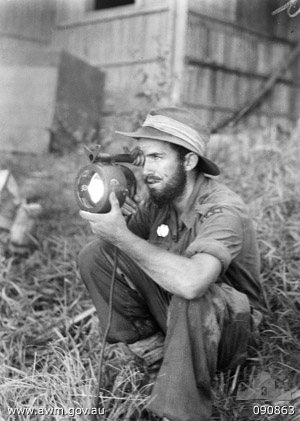
A commando is a combatant, or operative of an elite light infantry or special operations force using dedicated operation techniques.

The Corps of Royal Marines (RM) is an amphibious light infantry and also one of the five fighting arms of the Royal Navy. The marines can trace their origins back to the formation of the English Army's "Duke of York and Albany's maritime regiment of Foot" at the grounds of the Honourable Artillery Company on 28 October 1664.

The Commandos Marine are the Special Operation Forces (SOF) of the French Navy. The Commandos Marine are nicknamed Bérets Verts. They operate under the Naval Riflemen and Special Operations Forces Command (FORFUSCO) and form part of the French Special Operations Command.

Underwater Demolition Teams (UDT), or frogmen, were amphibious units created by the United States Navy during World War II with specialized non-tactical missions. They were predecessors of the navy's current SEAL teams.

The United States Naval Special Warfare Command (NAVSPECWARCOM), also known as WARCOM is the Naval component of United States Special Operations Command, the unified command responsible for overseeing and conducting the nation's special operations and missions.

The Borneo campaign of 1945 was the last major Allied campaign in the South West Pacific Area during World War II to liberate Japanese-held British Borneo and Dutch Borneo. Designated collectively as Operation Oboe, a series of amphibious assaults between 1 May and 21 July were conducted by the Australian I Corps, under Lieutenant-General Leslie Morshead, against Imperial Japanese forces who had been occupying the island since late 1941 – early 1942. The main Japanese formation on the island was the Thirty-Seventh Army under Lieutenant-General Masao Baba, while the naval garrison was commanded by Vice-Admiral Michiaki Kamada. The Australian ground forces were supported by US and other Allied air and naval forces, with the US providing the bulk of the shipping and logistic support necessary to conduct the operation. The campaign was initially planned to involve six stages, but eventually landings were undertaken at four locations: Tarakan, Labuan, North Borneo and Balikpapan. Guerilla operations were also carried out by Dayak tribesmen and small numbers of Allied personnel in the interior of the island. While major combat operations were concluded by mid-July, mopping-up operations continued throughout Borneo until the end of the war in August. Initially intended to secure vital airfields and port facilities to support future operations, preparatory bombardment resulted in heavy damage to the island's infrastructure, including its oil production facilities. As a result, the strategic benefits the Allies gained from the campaign were negligible.

The Battle of Tarakan was the first stage in the Borneo campaign of 1945. It began with an amphibious landing by Allied forces on 1 May, code-named Operation Oboe One; the Allied ground forces were drawn mainly from the Australian 26th Brigade, but included a small element of Netherlands East Indies personnel. The main objective of the landing was the capture of the island's airfield. While the battle ended with success for the Allied forces over the Japanese defenders, this victory is generally regarded as having not justified its costs. The airfield was so heavily damaged that it ultimately could not be repaired in time to make it operational for other phases of the Allied campaign in Borneo.

Marines, or naval infantry, are typically a military force trained to operate in littoral zones in support of naval operations. Historically, tasks undertaken by marines have included helping maintain discipline and order aboard the ship, the boarding of vessels during combat or capture of prize ships, and providing manpower for raiding ashore in support of the naval objectives. In most countries, the marines are an integral part of that state's navy.

Beach Jumpers were U.S. Navy special warfare units organized during World War II by Lieutenant Douglas Fairbanks Jr.. They specialized in deception and psychological warfare. The units were active from 1943 to 1946 and 1951 to 1972.

Lieutenant General Sir Edmund Francis Herring, was a senior Australian Army officer during the Second World War, Lieutenant Governor of Victoria, and Chief Justice of the Supreme Court of Victoria. A Rhodes scholar, Herring was at New College, Oxford, when the First World War broke out and served with the Royal Field Artillery on the Macedonian front, for which he was awarded the Military Cross and Distinguished Service Order. After the war he carved out a successful career as a barrister and King's Counsel. He also joined the Australian Army, rising to the rank of colonel by 1939.
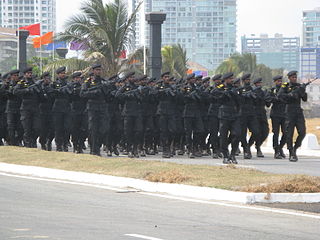
The Special Boat Squadron is the Sri Lanka Navy's elite special forces unit, modeled after the British Special Boat Service. It was raised in 1993 and fought in the Sri Lankan Civil War.

HMAS Assault is a former Royal Australian Navy (RAN) training centre that was in use during World War II, located at Nelson Bay in the Mid North Coast region of New South Wales, Australia.
The history of the Royal Marines began on 28 October 1664 with the formation of the Duke of York and Albany's Maritime Regiment of Foot soon becoming known as the Admiral's Regiment. During the War of the Spanish Succession the most historic achievement of the Marines was the capture of the mole during the assault on Gibraltar in 1704. On 5 April 1755, His Majesty's Marine Forces, fifty Companies in three Divisions, headquartered at Portsmouth, Chatham and Plymouth, were formed by Order of Council under Admiralty control.
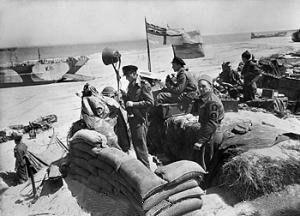
The Royal Naval Commandos, also known as RN Beachhead Commandos, were a commando formation of the Royal Navy which served during the Second World War. The first units were raised in 1942 and by the end of the war, 22 company-sized units had been raised to carry out various tasks associated with establishing, maintaining and controlling beachheads during amphibious operations. The Beach Commando's principle duty was "the quick and safe turnaround of all boats on the beaches"
Beachmaster Unit One, (BMU-1) is a United States Navy amphibious beach party unit based at Naval Amphibious Base Coronado in Coronado, California. BMU-1 is the sister unit of Beachmaster Unit Two located in Norfolk, Virginia.
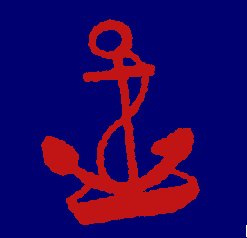
The Royal Australian Naval Bridging Train was a unique unit of the Royal Australian Navy. It was active only during the First World War, where it served in the Gallipoli and the Sinai and Palestine Campaigns. The Train was formed in February 1915 and stood down in May 1917. Throughout its existence, it was composed of Royal Australian Naval Reservists under the command of Lieutenant Commander Leighton Bracegirdle. Normally under the command of the British IX Corps, the Train also supported the I ANZAC Corps and Imperial Camel Corps in the defence of the Suez Canal.
They were the only Australian naval unit serving in a European theatre of war. They were therefore bent on proving, both to the Royal Navy and to the British Army, that they could overcome any difficulties.
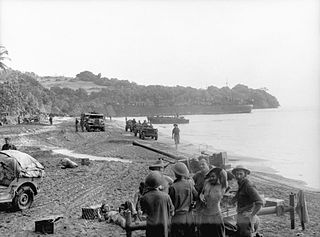
The Landing at Scarlet Beach took place in New Guinea during the Huon Peninsula campaign of the Second World War, involving forces from Australia, the United States and Japan. Allied forces landed at Scarlet Beach, north of Siki Cove and south of the Song River, to the east of Katika and about 10 kilometres (6.2 mi) north of Finschhafen. The capture of Finschhafen allowed the construction of air base and naval facilities to assist Allied air and naval forces to conduct operations against Japanese bases in New Guinea and New Britain.

During the Second World War, the Allies realised the need for the landing zone of an amphibious assault to be organised for the efficient passage of follow on forces. The British formed such units from all three services – the Royal Navy (Commandos), British Army and the Royal Air Force, with the Army component comprising Infantry, Engineers, Ordnance, Royal Electrical and Mechanical Engineers, Medical and Service Corps.

Assault Craft Unit TWO (ACU-2) is an Atlantic Ocean Maritime Prepositioning Force in the United States Navy operated under Naval Beach Group Two out of Naval Amphibious Base Little Creek, Virginia. ACU-2's force consists of Landing Craft Utility boats (LCU), Landing Craft Mechanized, Mark 8 boats (LCM), and Maritime Prepositioning Force Utility Boats (MPFUB). The sister unit of ACU-2 is Assault Craft Unit 1 in Naval Amphibious Base Coronado.
Naval Beach Unit Seven, (NBU-7) is a United States Navy amphibious unit based at United States Fleet Activities Sasebo in Sasebo, Japan.
